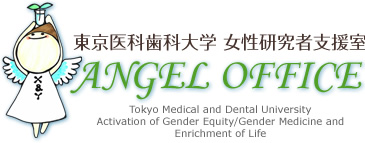Messages
Developments in the Second Year of the Support Model Activities for Female Researchers
The activities concerning the "innovative support for female researchers" that we adopted in FY2008 were developed using the Special Coordination Funds for Promoting Science and Technology provided by Japan’s Ministry of Education, Culture, Sports, Science and Technology (MEXT) under the heading "support model activities for female researchers" and are now in their second year. Starting from this fiscal year, we intend to extend the scope of these activities to include the entire school by widening their application to the Graduate School of Medical and Dental Studies (including the Faculty of Medicine and the Faculty of Dentistry) in addition to the three departments covered in the previous fiscal year (Graduate School of Biomedical Science, the Medical Research Institute and the Institute of Biomaterials and Bioengineering). As our agenda is to involve the entire university, the deans for the Faculty of Medicine and Faculty of Dentistry are participating as members of the executive council. Additionally, we plan to hold a Support Measures Conference for Female Researchers with representatives from each department in order to establish 11 different types of activities including: employment, working condition and evaluation activities, home-based research activities, research support personnel assignment activities, child care activities, career support activities such as exchange meetings, role model training, and career counseling, awareness activities, research and enlightenment activities that form a basis for gender-specific medical studies, and PR activities. Members from the university will be assigned as leaders for each of these activities. The Support Measures Committee for Female Researchers will be formed via the Support Office for Female Researchers and the Support Measures Conference for Female Researchers for creating workplace environments that optimize the abilities of a diverse range of female researchers and carrying out activities based on organized cooperation between these two parties.
These activities are designed to be implemented as a model for developmental activities over a three-year period, and will serve as a challenge to determine the type of support this university is able to offer female researchers. While developing the activities into the next fiscal year (the final year for these activities), we intend to create a platform that will enable us to continue their implementation in the future.
Hisashi Taniguchi
University Dean & Vice-president for the
Support Model Activities for Female Researchers
Message From A Specially Appointed Professor
In September 2008, I was appointed Special Professor of the Support Office for Female Researchers, and my first decision in this post was to have the walls of Room 477 on the 4th Floor of the Yushima No.3 Building painted pale pink. In October, my computer and telephone were finally installed, and I officially opened the Support Office by hanging a lithograph entitled "The Beautiful Bridge to the Future" by Fujishiro Seiji. This picture was made to commemorate the marriage of Japan’s Princess Masako and depicts two trees snuggled together in front of a boy and girl with a path extending up into the sky. I chose this picture to show that the Support Office not only aims to assist women with their careers and life, but also men.
I graduated from Keio University in 1982, and after specializing in Hematology at the Department of Internal Medicine, took my child with me overseas to attend UCSF where I conducted research into cell adhesion. In order to coordinate my work with child rearing, I switched to the position of employment medical advisor and have been advising women on how to maintain a healthy career ever since.
I am interested in the interaction between biological gender differences and sociocultural gender differences, and translated "Exploring the biological contributions to human health. Does sex matter?" which had just been released at the time. This was the first time Japan had seen an "introduction to gender-specific medical studies," and it led to the publication of the magazine "Gender Differences & Health Care." Data was collected on gender-specific medical studies within Japan, and I was pleased to see this develop into a network of numerous researchers and medical professionals.
Through mediums such as the Female Experts Conference that focuses on gender and health (chaired by Masako Horiguchi) and a gender-specific medical studies information network (chaired by Keiko Amano) I have been able to meet women with many high aspirations and see first hand how networks are able to provide emotional support.
I am Female Physician Support Committee Chairman for the Japan Medical Women's Association (JMWA) and provide support for the lives and careers of female physicians.
I was appointed Special Professor of the Support Office at the introduction of Professor Tsugawa (currently of Tokyo University), and through my involvement in gender-specific medical studies, provide strong support to new female (and male) researchers engaged in the advancement of IT and globalization who join Tokyo Medical and Dental University. This project is named ANGEL, an acronym for (Activation of Gender Equity/Gender Medicine and Enrichment of Life), and its logo features an angel with letters that represent the X and Y genes on her chest while she carries a test tube over her head, indicating the science behind life.
We hope to work together with everyone involved.
Yoko Araki
Logo

We aim to enrich the lives of everyone through optimizing the capabilities of both men and women based on gender equality and promoting medical studies that take into account gender differences.
We have designed a logo that represents the scientific pursuit and fostering of the miracle of life woven together through the X and Y chromosomes.
